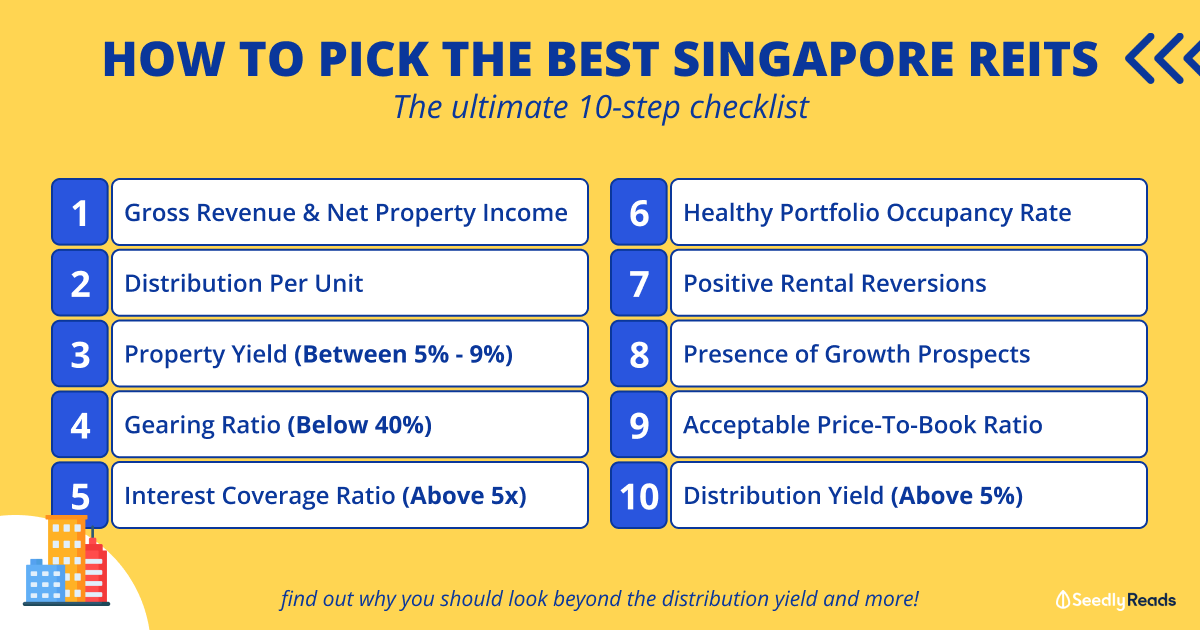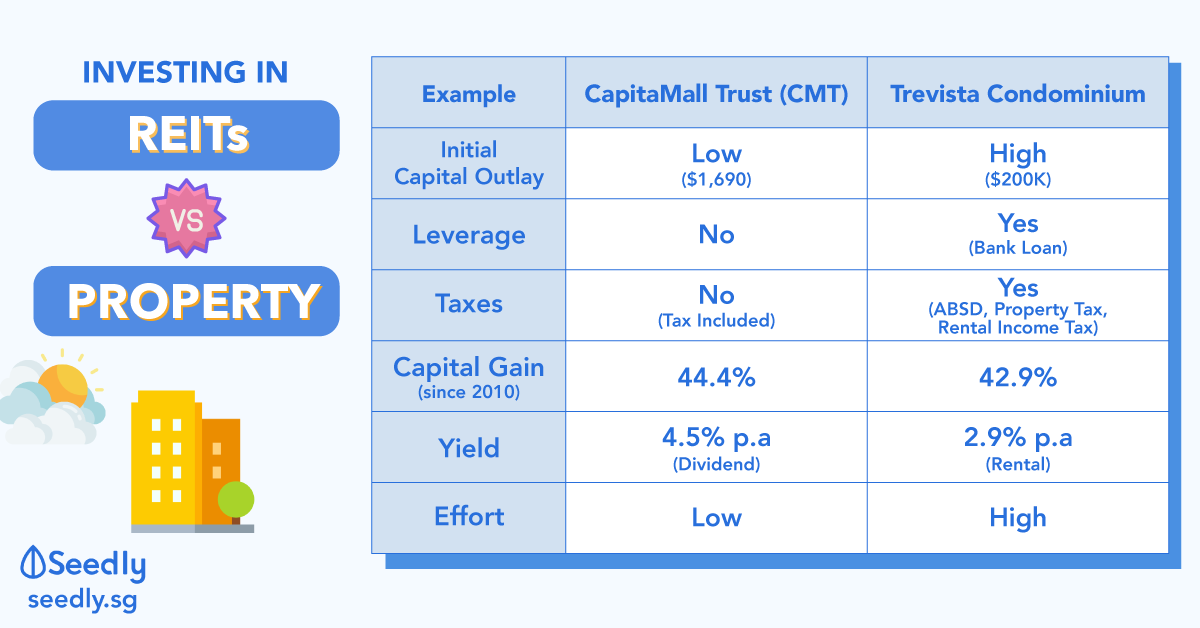I saw a REIT report recently and decided to do a quick summary here for our community! Hope this helps and I was also personally reviewing my portfolio over the weekend to decide if I should review my REITs allocation mainly in the retail and office commercial spaces in Singapore.

Positives:
Huge amounts of government and agency support (eg cash grants and rental waivers)
Overall outlook for REITs still make sense in a globally connected Singapore and APAC HQ/home for MNCs across the world
Singapore government is keen to ensure that Singapore remains competitive as a hub for APAC and investments all around
Negatives:
Near term distribution (DPU) might dip for shareholders (due to 12 months extension)
Could the new-normal be a world with the lower levels of retail consumption and tourism (which constitutes a large chunk for Retail REITs)
More SMEs and maybe MNCs shutting down in the near term due to poor market conditions.
OCBC REITs Report Summary:
Overall, we believe these measures provide much needed assistance and flexibility for the sector to navigate a tough economic environment ahead. Given the prevailing economic challenges, we believe investors should take a long-term view on REITs and be prepared that distributions-per-unit might dip in the near-term.
Investors should also stay selective on the sector given the recent run up in the market and focus on quality REITs with strong sponsors, healthy balance sheets and reasonable valuations.

Full details of the report:
PART 1: RENTAL SUPPORT FOR SMES
The local government has introduced a slew of measures to support Singapore REITs in the face of economic challenges caused by the Covid-19 pandemic, with the most recent one being Rental Support for SMEs under the fourth stimulus budget (Fortitude Budget).
Let’s take a look at some of these measures and what they mean for Singapore REITs and their investors.
1. Cash Grants
The government will provide cash grants amounting to about 0.8 months of rent to SME tenants (i.e. with less than S$100m in annual turnover) of commercial properties and 0.64 months of rent to SME tenants of industrial and office properties.
Taken together with the property tax rebate announced previously, total government support for qualifying commercial properties would be approximately two months of rent and approximately 1 month of rent for industrial and office properties.
These cash grants will be a boon for the industrial sub-sector, which we believe has a larger proportion of SME tenants within their portfolios.
For the office REITs, the bulk of their tenants in Singapore are likely multinational corporations (MNCs), given the location of their assets.
As for retail REITs, we believe there would be a fair share of tenants (i.e. specialty retailers, mom and pop stores) that would be able to qualify for the government cash grants. However, retail REITs with more significant Orchard Road exposure are likely to have less SME tenants in their portfolio.
2. Rental Waivers
The Ministry of Law has introduced a Bill mandating that landlords grant rental waivers to SME tenants who have suffered a significant drop in revenue in the past few months.
While this would negatively impact near-term cash flows of most Singapore REITs, we believe such short-term pain is a small price to pay for longer-term stability.
Ensuring the survival of their tenants would have far-reaching benefits in view that any backfilling of vacancies would likely take an extended period of time amid a global recession.

PART 2: INTER-AGENCY SUPPORT FOR REITS
Prior to the Fortitude Budget, the Internal Revenue Authority of Singapore (IRAS), Monetary Authority of Singapore (MAS) and Ministry of Finance (MOF) had jointly announced three key measures to help Singapore REITs ride out the tough economic environment ahead.
These measures include:
- A 12-month extension for local REITs to distribute 90% of their taxable income to investors to qualify for tax transparency
Together, these measures provide more flexibility for REITs to manage their cash flows and adjust their capital structure.












I saw a REIT report recently and decided to do a quick summary here for our community! Hope this helps and I was also personally reviewing my portfolio over the weekend to decide if I should review my REITs allocation mainly in the retail and office commercial spaces in Singapore.
Positives:
Huge amounts of government and agency support (eg cash grants and rental waivers)
Overall outlook for REITs still make sense in a globally connected Singapore and APAC HQ/home for MNCs across the world
Singapore government is keen to ensure that Singapore remains competitive as a hub for APAC and investments all around
Negatives:
Near term distribution (DPU) might dip for shareholders (due to 12 months extension)
Could the new-normal be a world with the lower levels of retail consumption and tourism (which constitutes a large chunk for Retail REITs)
More SMEs and maybe MNCs shutting down in the near term due to poor market conditions.
OCBC REITs Report Summary:
Overall, we believe these measures provide much needed assistance and flexibility for the sector to navigate a tough economic environment ahead. Given the prevailing economic challenges, we believe investors should take a long-term view on REITs and be prepared that distributions-per-unit might dip in the near-term.
Investors should also stay selective on the sector given the recent run up in the market and focus on quality REITs with strong sponsors, healthy balance sheets and reasonable valuations.
Full details of the report:
PART 1: RENTAL SUPPORT FOR SMES
The local government has introduced a slew of measures to support Singapore REITs in the face of economic challenges caused by the Covid-19 pandemic, with the most recent one being Rental Support for SMEs under the fourth stimulus budget (Fortitude Budget).
Let’s take a look at some of these measures and what they mean for Singapore REITs and their investors.
1. Cash Grants
The government will provide cash grants amounting to about 0.8 months of rent to SME tenants (i.e. with less than S$100m in annual turnover) of commercial properties and 0.64 months of rent to SME tenants of industrial and office properties.
Taken together with the property tax rebate announced previously, total government support for qualifying commercial properties would be approximately two months of rent and approximately 1 month of rent for industrial and office properties.
These cash grants will be a boon for the industrial sub-sector, which we believe has a larger proportion of SME tenants within their portfolios.
For the office REITs, the bulk of their tenants in Singapore are likely multinational corporations (MNCs), given the location of their assets.
As for retail REITs, we believe there would be a fair share of tenants (i.e. specialty retailers, mom and pop stores) that would be able to qualify for the government cash grants. However, retail REITs with more significant Orchard Road exposure are likely to have less SME tenants in their portfolio.
2. Rental Waivers
The Ministry of Law has introduced a Bill mandating that landlords grant rental waivers to SME tenants who have suffered a significant drop in revenue in the past few months.
While this would negatively impact near-term cash flows of most Singapore REITs, we believe such short-term pain is a small price to pay for longer-term stability.
Ensuring the survival of their tenants would have far-reaching benefits in view that any backfilling of vacancies would likely take an extended period of time amid a global recession.
PART 2: INTER-AGENCY SUPPORT FOR REITS
Prior to the Fortitude Budget, the Internal Revenue Authority of Singapore (IRAS), Monetary Authority of Singapore (MAS) and Ministry of Finance (MOF) had jointly announced three key measures to help Singapore REITs ride out the tough economic environment ahead.
These measures include:
Increasing the leverage limit for Singapore REITs from 45% to 50%
Delaying the minimum interest coverage ratio requirement to 1 January 2022
Together, these measures provide more flexibility for REITs to manage their cash flows and adjust their capital structure.